An Eye On the Horizon
- By Brandon Barrett
- 01/01/15

PHOTO COURTESY OF JEFFREY DUBOIS
Each year brings new challenges for students and professors of colleges and universities, just as each year brings a unique set of trends and possibilities. What was cutting-edge last year could be this year’s old news. There could also be a new technology or pedagogy poised to change what it means to work and learn in the world of higher education.
Simply trying to predict higher education trends does little good. Being aware of them is what gives students, professors, administrators and institutions the power to experiment and find out what new ideas will truly enhance the learning experience.
The following trends have been compiled by the staff of College Planning and Management magazine and serve as a good starting point to learning about what is new on the scene and what continues to drive innovation on campus.
From digital signage to the growing presence of social media in the classroom, technology is always one of the largest areas of trend growth in the higher education landscape. Whereas past years have been more focused on the increase in the number of online courses and MOOCs, 2015 seems to be a year that will see the blossoming of on-campus technology trends. Following are some of the trends that will likely continue to grow in 2015.

PHOTOS COURTESY OF FLORIDA POLYTECHNIC UNIVERSITY
Digital Signage: Pointing the Way
“We schedule two campus tours a day, and the session begins at the Visitor’s Center, and let me tell you, seeing those prospective students standing in amazement in front of our digital video wall is a picture worth a thousand words,” says Spencer Graham, manager of Operations, Information Services, at West Virginia University (WVU) in Morgantown. Clearly, Graham does not doubt the power of digital signage when it comes to impacting student life and even college selection. “It [digital signage] has touched almost everything on our campus, from campus tours to security,” he continues.
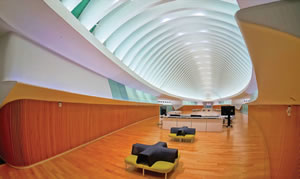
PHOTOS COURTESY OF FLORIDA POLYTECHNIC UNIVERSITY
Digital signage, while far from a new campus trend, has been evolving quickly. Once primarily used for wayfinding and to broadcast event details, the medium now serves countless purposes, ranging from real-time menu boards in cafeterias to interactive highlight reels for campus athletic facilities. With the change in use has come a shift in scope for digital signage on many campuses.
“At one time, a campus may have had a small handful of digital signs,” says Richard Ventura, vice president of product marketing and solutions for NEC Display Solutions. “Now they are running entire digital signage programs, with each department doing their own thing, but in a cohesive, uniform way.” This growth is what has moved digital signage from a simple niche to a full-blown trend, especially on college campuses, whether large or small, Ventura adds.

PHOTOS COURTESY OF FLORIDA POLYTECHNIC UNIVERSITY
Colleges and universities strive to create a cohesive campus brand. The departments of those institutions usually want to forge a unique identity, with an emphasis placed on what sets their students, faculty and research apart. Trend-wise, 2015 should be an interesting year for digital signage. Institutions will continue to find ways to give departments autonomy while keeping things consistent, brand-wise. It will also be a year filled with schools finding new ways to attract students via digital signage, as in the case of WVU.
With events like the Digital Signage Expo (DSE, www.digitalsignageexpo.net) featuring presentations on everything from campus emergency alert systems to athletics uses, it is clear that the demand for digital signage is growing. “The DSE is a great resource for schools,” says Graham. “I think the magnitude of the event shows the great level of interest and use for digital signage on campuses in the future.”
One thing is for sure: the days of needing to read a campus newspaper or website to find announcements or safety notices are fading. Digital signage continues to change the way information is spread across a campus.
Social Media: Sharing Education
Facebook, Twitter, Instagram, Pinterest: all names that were once banned from the college classroom, but are now becoming an active, if not central, part of academic life. Reynol Junco, a professor of Education at Iowa State University and leading educational social media researcher, first noticed the shift early in his teaching and research. “There is, now more than ever, the potential for faculty to better engage their students using social media,” he says. “It is more than just a passing fad.”

PHOTOS COURTESY OF FLORIDA POLYTECHNIC UNIVERSITY
The development of social media as an educational tool at the college level has been gradual, but is beginning to take shape as 2014 comes to a close. “There is no truly widespread adoption quite yet,” says Junco, “An interest is certainly developing and some important outcome studies [concerning social media and higher education] are being performed. That is a productive step in the right direction.”
Imagine being able to organize learning communities as Facebook groups, or studying the Twitter feeds of modern literary icons and being able to interact with them directly and in real-time. Those are possibilities that social media offers when used in a fitting way in the classroom. “Many studies are geared toward finding appropriate uses, and teaching students how to apply those uses in a meaningful and educational way,” continues Professor Junco. “Social media can be used in personal, educational and professional ways in the classroom; the key is to tie those together.”

PHOTOS COURTESY OF FLORIDA POLYTECHNIC UNIVERSITY
The pace of the acceptance of social media is picking up. Many colleges and universities, along with their individual departments, are creating Facebook, Twitter and Instagram profiles to keep prospective, current and past students updated. As this happens, the in-classroom element is also being explored, and different social media platforms adopted for new academic uses.
Social media can give students a voice, but can also serve as a distraction, or even a dangerous place for learning, at times. In 2015, students and professors will continue to refine the ways in which social media can be used for positive classroom benefit, and also discover ways in which the potentially negative aspects can be minimized.
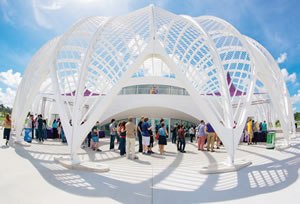
PHOTOS COURTESY OF FLORIDA POLYTECHNIC UNIVERSITY
Data for Design
All architects, engineers and college administrators wish they could see the future when a big building project is in the works. Through the use of big data in a project’s planning or conceptual phase, that wish is suddenly much more attainable. Knowing what students will want and need from their facilities is never a sure thing, but sometimes, running the numbers gives administrators a better idea.
Vinicius Gorgati, principal at Sasaki Associates, Inc., has seen this trend flourish in recent years, and says that it informs the design and planning process from the start of a project. “We start by trying to figure out where the heart of the campus is. What the population likes and doesn’t like, which classrooms and dorms are relevant to student life. We then ask the college, ‘what are you trying to achieve? What is your mission with this project?’”
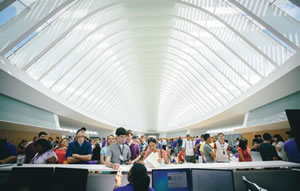
PHOTOS COURTESY OF FLORIDA POLYTECHNIC UNIVERSITY
According to Gorgati, asking such questions at the start of a largescale effort helps the process to go more smoothly, all the way to completion. “By taking surveys and asking questions, we have a chance to figure things out at the beginning, which makes things much easier, all the way through,” he says. Big data is helping streamline the process for large and small architecture firms, both in planning and execution of projects.
“A myriad of perspectives and data not only make things easier, but also give us the tools we need to give colleges exactly what they need,” continues Gorgati. The days of architects and designers guessing about client needs are over. What will 2015 bring?
“I think there will be a much larger emphasis placed on diversity and making everything equal, experience-wise, for all students, regardless of the background or attributes they are bringing to college,” states Gorgati. “I think there will be an emphasis placed on this in 2015, even more than in past years.” With data accumulation and analysis at the forefront of the campus planning and building process, it seems as though giving all students a great experience is now closer than ever.
With firms like Sasaki and others paving the way for data-driven campus planning, 2015 is poised to be the year in which campus populations are able to control the planning and design of their environment. It is also the year in which architects and designers continue to better understand the needs and wants of those they are helping. One thing is for sure: big data and design were seemingly made for each other.
How Secure is (Cyber) Secure?
Every week, the news seems to have a new story about a data breach or other online security scare. Everyone who hears these stories should take them to heart, and take precautions to ensure that they are safe when online. What if you are a CTO or other high-level IT administrator at a college or university? Then perhaps you should take these stories even more to heart, as institutional networks continue to grow in scope and the amount of sensitive data they store grows right along with them.
David Dodd, vice president of Information Technology and CIO at the Stevens Institute of Technology in Hoboken, NJ, notes this fact when asked about the cybersecurity challenges facing institutions. “Colleges and universities are excellent targets for cyber terrorism and for cyber espionage. We host large volumes of confidential information, and yet operate in an open environment of free inquiry and information sharing. This creates enormous challenges,” he says.
Colleges and universities will be faced with new challenges on a daily basis when it comes to keeping their information safe, secure and open. With this being the case, 2015 will be a year spent figuring out how to better protect information; a task Dodd notes is certainly doable. “The best response is working with extraordinarily good technology partners and utilizing the most up-to-date and solid solutions available that not only provide perimeter firewall protection, but also adaptive intrusion detection and real-time countermeasures.”
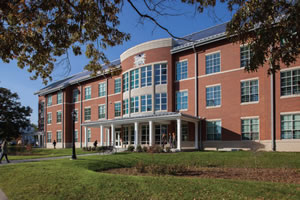
PHOTOS COURTESY OF HASTINGS & CHIVETTA ARCHITECTS, INC.
Exactly what cybersecurity trends will the higher education space be seeing in 2015? “In the background, strong networking and informationsharing concerning emerging threats is critical because it allows a single detected instance to be shared rapidly, and protections updated quickly across our educational community,” says Dodd. Working together will be a critical trend that will dictate information security.
The importance of keeping a college’s data safe is just as important as keeping the physical facility secure. Any kind of breach of student privacy, or of college or university financial information, can be detrimental. As hackers and other cybercriminals continue to grow in number and in cunning, the need for protecting against them grows exponentially. “In the end, information is an incredibly powerful equalizer,” confirms Dodd. The battle for, and to protect information, while nothing new, will continue to dominate the headlines, and shape IT strategy at colleges and universities around the world.
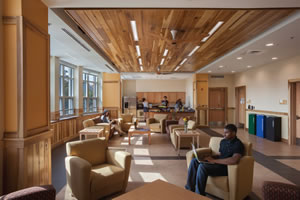
PHOTOS COURTESY OF HASTINGS & CHIVETTA ARCHITECTS, INC.
Data-Driven Decisions (for Schools and Students)
“Big data.” The phrase is used in many sectors of modern industry, from tech to accounting. As colleges and universities work to attract and retain students in a tighter academic market, the idea of using big data-driven recruitment methods makes sense. As more and more admissions departments adopt these tactics, big data is quickly becoming one of the hottest trends poised to shape the recruitment landscape.
“Data analysis has become critical to higher education, and enrollment management at York College is no exception. We now have the ability to distill large amounts of national data and statistics and determine trends that can then be applied to York and our students,” says Janine Becker, dean of enrollment at York College in Pennsylvania. At schools like York, statistics and other data are used for a variety of tasks, including the identification of at-risk students, outlining successful recruitment methods and properly leveraging resources.
At York, and other institutions, the idea that the future can be visualized in the present, via analytics and statistics, is reshaping the admissions process. “We use predictive modeling to identify those students most likely to enroll — this then informs the entire recruitment process,” confirms Becker. “We are able to identify those students who are likely to be most successful at our institution [with this model].”
As big data continues to grow, the process of using statistics to identify student needs and wants will continue to undergo refining. “There are some obstacles when using so much information to predict trends and courses of action. These include a lack of human resources with the skills and ability to “crunch” the numbers… and even technological limitations,” notes Becker.
While solutions to such problems are created and tested, colleges and universities will continue to use big data as a decision-making tool, albeit with a careful eye. “I try to be sure and leave room for students who may fall outside the trends suggested by the data analysis only but who may be a great student for York,” says Becker. Leaving room for such students is important. The year of 2015 promises to be one where big data is tested, modified, trusted, perfected and, in turn, it will continue to change the way institutions reach out to students and parents.
Christopher Bridges, vice president for student affairs and enrollment at Mansfield University in Pennsylvania, says it best: “Big data isn’t a savior; it won’t inherently change education, or the students’ experience and success. The questions still come back to resources and personal follow up.”
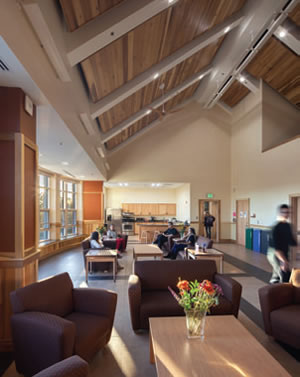
PHOTOS COURTESY OF HASTINGS & CHIVETTA ARCHITECTS, INC.
Sustainable Spaces for Student Living
The face of residence halls has changed. What were once giant cinderblock high rises are more and more becoming modern, sleek and sustainable places for students to learn and grow. “Healthy and sustainable. That is the new ‘it’ when talking about campus facilities, especially dorms,” says Roger Smith of BBS Architects. “A dorm can become an educational structure that teaches students about sustainability through daily living. That is a pretty new idea.”
Green student living is one that has been important in 2014, and will continue to be a hot trend in 2015. “I think more institutions will be expressing to their students that their dorms are green and will continue to help them identify what that means,” confirms Smith.
Aside from giving students the opportunity to learn about sustainability through their dorm rooms, many institutions will also be collaborating with off-campus builders to maximize space in an environmentally friendly way.
“On-campus and off-campus builders have been collaborating, and the result is usually sustainable, which isn’t always the case without institutional involvement. I don’t see that changing,” notes Dave Nelson, vice president at Carter, an Atlanta-based real estate investment, development and advisory firm. Whether a public-private partnership, or simply a university building project, the idea of sustainable dorms is taking hold.
“The quality and sustainability level of the housing is going up every year,” says Nelson. “The materials and methods have improved consistently.” So what will sustainable dorms look like in 2015? Schools will continue to use sustainable materials, but a greater emphasis will be placed within the walls, on efficient uses of heating and cooling and the building envelope.
Health and Wellness
Parents and students trust colleges and universities to provide a great educational experience while keeping everyone safe and healthy. The concept of student health and wellness has grown in importance over the past decade, and 2015 promises to continue that trend in a variety of ways.
Mark Stoller, principal at YGH Architects, has seen this trend blossom. “First, schools were keeping the health and wellness centers apart. Now, there has been an emphasis on integrating the mental and physical health services with the student rec center,” he says. This centralization of services is helping students to lead healthier lives and giving them easier access to services.
Aside from securing students a central place to get health services and a great workout, many institutions are seeking alternative ways to keep students healthy and engaged. “Keeping students active and healthy is huge,” says Stoller. “Not everyone wants to lift weights and run on a treadmill, so what better way to do that than through intramural sports activities?”
In fact, intramural sports are seen as so important at some schools that official collegiate athletic facilities are made available for the groups to use. Oregon State is one of these schools, allowing intramural groups to use the Athletic Department’s facilities. “Schools realize that staying active is important, which gives them a reason to share facilities,” confirms Stoller.
Along with intramural sports and activity groups, schools like The Evergreen State University in Olympia, WA, are planning other ways for their students to remain active, regardless of the weather. “They are in the process of planning an outdoor ‘activity shed’,” says Stoller. “The students there prefer alternative ways to be active, especially outdoors, so they are giving them a way, whether it rains or not.”
Physical activity, regardless of age, is now viewed as an essential component of a healthy lifestyle. For college students, the threat of growing sedentary due to hours of study and time in the classroom means that exercise is an even more critical component to good health. In 2015, student health will remain a critical priority, while colleges and universities continue to search for new ways to promote activity and student wellness on campus.
This article originally appeared in the issue of .